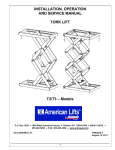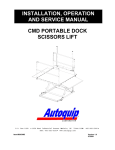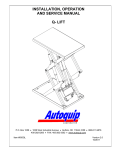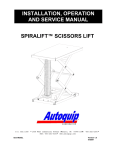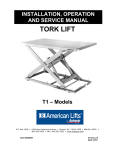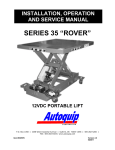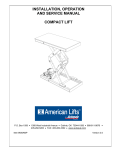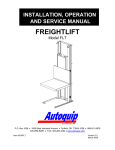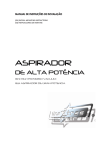Download LOW REACH PAN LIFT Model XLR INSTALLATION, OPERATION
Transcript
INSTALLATION, OPERATION AND SERVICE MANUAL LOW REACH PAN LIFT Model XLR P.O. Box 1058 • 1058 West Industrial Avenue • Guthrie, OK 73044-1058 • 405-282-5200 • FAX: 405-282-8105 • www.autoquip.com 830XLR Version 1.0 06/2003 TABLE OF CONTENTS Identification and Inspection 3 Safety Signal Words 4 Safety Practices 5 Label Identification 8 Specifications 11 Lift Blocking Instructions 13 Installation Instructions 16 Operating Instructions 18 Routine Maintenance 19 General Maintenance 21 Replacement Parts List 32 Troubleshooting Analysis 33 IMPORTANT Please read and understand this manual prior to installation or operation of this lift. Failure to do so could lead to property damage and/or serious personal injury. If any questions arise, call a local representative or Autoquip Corporation at 1-888-811-9876 or 405-282-5200. PLANNED MAINTENANCE PROGRAM A local Autoquip representative provides a Planned Maintenance Program (PMP) for this equipment using factory-trained personnel. Call a local representative or Autoquip Corporation at 1-888-811-9876 or 405-282-5200 for more information. 2 IDENTIFICATION & INSPECTION IDENTIFICATION When ordering parts or requesting information or service on this lift, PLEASE REFER TO THE MODEL AND SERIAL NUMBER. This information is on a nameplate attached to the leg assembly. Replacement parts are available from a local Autoquip distributor. INSPECTION Immediately upon receipt of the lift, a visual inspection should be made to determine that it has not been damaged in transit. Any damage found must be noted on the delivery receipt. In addition to this preliminary inspection, the lift should be carefully inspected for concealed damage. Any concealed damage found that was not noted on the delivery receipt should be reported in writing to the delivering carrier within 48 hours. The following is a checklist that will aid you in the inspection of this lift: 1. Examine entire unit for any signs of mishandling. Pay special attention to the power unit and pushbuttons. 2. Thoroughly examine all connections, making sure they have not vibrated loose during transit, and inspect wiring for any signs of damage. 3. After installation, raise the lift and inspect the base frame, platform, scissors assembly, and cylinder plumbing connections. 3 SAFETY SIGNAL WORDS SAFETY ALERTS (Required Reading!) The following SAFETY ALERTS are intended to create awareness of owners, operators, and maintenance personnel of the potential safety hazards and the steps that must be taken to avoid accidents. These same alerts are inserted throughout this manual to identify specific hazards that may endanger uninformed personnel. Identification of every conceivable hazardous situation is impossible. Therefore, all personnel have the responsibility to diligently exercise safe practices whenever exposed to this equipment. ____________________________________________________________ DANGER ! Identifies a hazardous situation that presents the imminent probability of death or of severe personal injury!! _____________________________________________________________ WARNING! Identifies a hazardous situation that has the potential of causing death or serious personal injury. CAUTION! Identifies a hazardous situation that could lead to the possibility of personal injury of death, and/or may result in equipment damage. _____________________________________________________________ 4 SAFETY PRACTICES Read and understand this manual and all labels prior to operating or servicing the lift. All labels are provided in accordance with ANSI Z535.4. DANGER ! Do not work under lift without maintenance device! To avoid personal injury, NEVER go under the lift platform until the load is removed and the scissors mechanism is securely blocked in the open position. See "Lift Blocking Instructions" section. DANGER! To avoid personal injury, stand clear of scissors leg mechanism while lift is in motion. DANGER! Do not install the lift in a pit unless it has a bevel toe guard or other approved toe protection. A shear point can exist which can cause severe injury to the foot. DANGER! HIGH VOLTAGE!! Disconnect and/or lock out the electrical supply to the power unit prior to any maintenance being performed. 5 SAFETY PRACTICES DANGER! Extending the platform length or width beyond the factory limit could cause the unit to tip, which could result in personal injury or death. DANGER! Do not attempt to remove the velocity fuse until the maintenance locks securely support the lift and all hydraulic pressure has been removed from the lifting cylinders and hydraulic hoses. Failure to do so could result in personal injury or death! WARNING! Under no circumstances should the speed control orifice be removed from the Deltatrol to obtain faster lowering speed. A loaded lift can reach dangerous and destructive speed!! WARNING! All warning and information decals should be in place as outlined in the “Label Identification” section. If decals are missing or damaged, they should be replaced with new ones. Contact an Autoquip representative for replacements. 6 SAFETY PRACTICES CAUTION! Never run the pump for more than a couple of seconds without pumping oil. This applies to low oil conditions, improper motor rotation, running the pump against the relief pressure after the lift is fully raised against the physical stops, running overloaded beyond capacity, or running at reduced speed because of pinched or obstructed hydraulic lines. CAUTION! Do not continue to depress the “UP” button on the controller if the lift is not raising or if the lift has reached the fully raised position. To do so may result in permanent damage to the motor or pump. CAUTION! Do not operate the power unit on relief for more than a few seconds. When on relief, the valve will make a squealing sound. CAUTION! Precautions should be taken to prevent the introduction of contaminates such as dirt or other foreign material into the system through open fittings, pipes or disassembled components. Contamination will ruin the hydraulic system. CAUTION! Use only approved oils in the lift. See “Specifications” section. 7 LABEL IDENTIFICATION 2 5 1 3 4 Figure 1 Label Placement Diagram XLR Item No. 1 2 3 4 5 Qty 2 4 1 1 2 Description Caution – Familiarize Yourself With Operators Manual Danger – Do Not Put Hands or Feet . . . Autoquip Serial Number Nameplate Fill with Recommended Oils Only Capacity 8 Part No. 36401487 36430050M 36401511 36400661 36401594 LABEL IDENTIFICATION Note: Labels shown here are not actual size. Figure 2 Label 36401487 CUT LINE Figure 3 Label 36430050M Figure 4 Label 36401511 9 LABEL IDENTIFICATION Figure 5 Label 36400661 Figure 6 Label 36401594 10 SPECIFICATIONS (in.) 36 36 36 36 36 36 36 36 36 Lifting Capacity (lbs.) 2000 2000 2000 3000 3000 3000 4000 4000 4000 Lowered Ht. (in.) 1/2 1/2 1/2 1/2 1/2 1/2 1/2 1/2 1/2 Side Reach -Over (in.) 4 4 4 4 4 4 4 4 4 48 48 48 48 48 48 48 48 48 2000 2000 2000 3000 3000 3000 4000 4000 4000 1/2 1/2 1/2 1/2 1/2 1/2 1/2 1/2 1/2 4 4 4 4 4 4 4 4 4 Model Travel 36XLR2040 36XLR2046 36XLR2052 36XLRA3040 36XLRA3046 36XLRA3052 36XLR4040 36XLR4046 36XLR4052 48XLR2040 48XLR2046 48XLR2052 48XLRA3040 48XLRA3046 48XLRA3052 48XLR4040 48XLR4046 48XLR4052 Platform Size (in.) 40 x 48 46 x 48 52 x 48 40 x 48 46 x 48 52 x 48 40 x 48 46 x 48 52 x 48 Base Size (in.) 40 x 48 46 x 48 52 x 48 40 x 48 46 x 48 52 x 48 40 x 48 46 x 48 52 x 48 40 46 52 40 46 52 40 46 52 40 46 52 40 46 52 40 46 52 x x x x x x x x x 64 64 64 64 64 64 64 64 64 x x x x x x x x x 64 64 64 64 64 64 64 64 64 Edge Load Capacity (lbs.) 1000 1000 1000 1000 1000 1000 2000 2000 2000 1000 1000 1000 1000 1000 1000 2000 2000 2000 Speed (sec.) 24 24 24 * * * 24 24 24 Shipping Wt (lbs.) 950 990 1030 1185 1225 1265 1040 1095 1150 32 32 32 * * * 32 32 32 1490 1530 1570 1345 1400 1455 1260 1315 1370 * Depends on air supply LOAD CAPACITY The load capacity rating is stamped on a metal plate attached to the lift. This figure is a net capacity rating for a lift furnished with the standard platform. The relief valve of the pumping unit has been set to raise the weight, plus a small amount for overload. Where gravity roll-sections, special tops, etc, are installed on the lift after leaving the plant, deduct the weight of these from the load rating to obtain the net capacity. Lifts should not be overloaded beyond the established capacity as damage and/or personal injury may result. UNBALANCED LOADING The stabilization provided is basically for balanced loads. If special attachments are needed to extend beyond the length and/or width dimensions of the pla tform, consult the factory for approval of all attachments or modifications to this equipment. Autoquip does not foresee and can not anticipate unauthorized modifications to this lift which may adversely affect the performance or safety of the lift and potentially cause permanent damage to the lift, which could in turn lead to severe injury or death. 11 SPECIFICATIONS PUMP PRESSURE This lift incorporates a positive displacement pump machined to a high degree of accuracy and specially adapted to requirements of higher-pressure ranges over that of a standard pump. Therefore, standard factory models of the same manufacture cannot replace it. The pump can operate efficiently at intermittent pressures up to 3200 PSI and continuous duty to 2500 PSI. The safety relief valve in the pump assembly is factoryset to stay within the parameters of the pump and lift requirements. 12 LIFT BLOCKING INSTRUCTIONS WARNING ! Only authorized personnel should perform inspection or maintenance and service procedures. Unauthorized personnel attempting these procedures do so at the risk of personal injury or death. DANGER ! Failure to properly adhere to lift blocking procedures is to risk the sudden and uncontrolled descent of the lift during maintenance or inspection. A falling lift can cause severe injury or death. This procedure describes the only factory-approved method of working under a lift. Follow these instructions EVERY time you plan to reach or crawl beneath the lift to perform service or maintenance – no matter how momentary that might be. If the factory-provided maintenance devices are damaged or missing, stop immediately and consult the factory for assistance. The manufacturer is not liable for your failure to use the approved maintenance devices and procedures that have been provided. 1. All load must be removed from the lift prior to engaging the maintenance devices. These devices are designed to support an unloaded lift only. Failure to remove the load from the lift prior to blocking could cause the failure of the maintenance devices and allow the lift to fall unexpectedly. This can result in personal injury or death, or permanent damage to the maintenance devices and/or the lift. 2. Raise the lift to its fully raised position. If you do not, the maintenance devices may not be able to be placed properly in their designed blocking position. 3. Locate both hinged maintenance locks permanently welded outside the base frame on the roller end of the lift base legs. Both locks must be flipped over and resting inside the base frame and thus in the roller path of the lift (See Figure 7). 4. Lower the lift platform until the leg rollers make contact with both maintenance locks. Re -check to ensure that both devices are fully and properly engaged with the leg rollers. If both left and right maintenance locks are not fully engaged the lift could fall unexpectedly, resulting in permanent damage to the devices or the lift. 13 LIFT BLOCKING INSTRUCTIONS FLIP-OVER MAINTENANCE LOCKS SHOWN IN PLACE ON BOTH SIDES OF BASE FRAME. Figure 7 Maintenance Locks 14 LIFT BLOCKING INSTRUCTIONS DANGER ! If for any reason you are unable to lower the lift completely onto the maintenance device(s), stop immediately and consult the factory. Failure to properly use the factory approved maintenance device(s) could result in severe injury or death. 5. Once the maintenance devices are properly and securely engaged, continue to press the down button, valve or switch for an additional 5-10 seconds to relieve all pressure in the hydraulic system (it could take longer in a pneumatic system). WARNING ! Failure to relieve operating system pressure could result in the sudden and unexpected release of high pressure fluids (or air) during maintenance and/or repair of the lift and result in severe injury or death. 6. Follow OSHA electrical lock-out/tag-out procedures. Disconnect and tag all electrical and/or other power sources to prevent an unplanned or unexpected actuation of the lift. 7. Once inspection or work is complete, reverse the performance of the steps above to raise the lift off the maintenance devices and flip the devices back into their designated storage positions outside the base frame. DANGER ! HIGH VOLTAGE!! – Disconnect and/or lock out the electrical supply to the power unit prior to any installation or maintenance being performed. 15 INSTALLATION INSTRUCTIONS 1. Make sure installation area is clean before starting. 2. If the permanent electrical work is not complete, some means of temporary lines with an on-off device for the power supply should be set up for testing purposes. 3. Place the lift in the installation area. CAUTION! When moving the lift, do not attempt to pick it up by the platform; it is hinged and could be damaged. Pick up the lift from under the base frame ONLY using a strap sling. 4. Make temporary electrical connections and permanent hydraulic connections. Raise the lift approximately one foot using the “UP” button. Then lower the lift back to fully collapse, holding the “DOWN” button for approximately 60 seconds. Repeat this process five to seven times to bleed any air out of the hydraulic system. 5. Raise the lift to the top of its travel and make positioning adjustments. Check for the proper height. If needed, shim to the desired height. DO NOT “spot” shim. Shim the full length of the base frame. This will prevent the frame from sagging under an exceptionally heavy load. DANGER ! Do not work under lift without Maintenance Device! To avoid personal injury, NEVER go under the lift platform until the load is removed and the scissors mechanism is securely blocked in the open position. See "Lift Blocking Instructions" section. 6. The base frame of the lift has pre-drilled holes for lagging it securely to the floor. Mark the holes, drill, and install with anchors. Lifts with oversize platforms have minimum pull out requirements of 2,000 lbs. for each anchor. 7. Make permanent electrical connections and operate the lift through a few cycles. 16 INSTALLATION INSTRUCTIONS CLEAN UP 1. Clean up any debris from the area. A clean installation makes a good impression and creates a much safer environment! 2. Touch-up paint is available from Autoquip for repair of damaged paint surfaces. WARNING! All DANGER, WARNING, and CAUTION labels and informational decals and plates must be intact and in place on the lift. Contact an Autoquip representative if labels are missing or damaged. See “DANGERS, WARNINGS, and CAUTIONS” section of this manual. 17 OPERATING INSTRUCTIONS 1. Scissors lifts have maximum lifting capacity ratings (See the “Specifications” section). The safety relief valve has been factory set to open at a point slightly above the rated load and allows the oil to bypass into the reservoir. The safety relief valve should not be adjusted for any reason as it could cause the motor or pump to prematurely burn out. Applying loads exceeding the rated capacity of the lift may result in excessive wear and damage to the lift. 2. This type of lift is designed primarily for in-plant applications and is furnished with constant-pressure pushbutton controls. Actuating the "UP" button will cause oil to enter the cylinders and the lift will rise. 3. When the desired height or upward travel of the platform is attained, removing the operators’ hand from the switch or button deactivates the “UP” circuit. The oil stops flowing and the upward movement will stop. Once the control switch or button is released the cylinders are locked into position at this height by a check valve in the circuit . 4. To lower the lift, activate the "DOWN" button. Opening the down control valve allows the oil in the cylinders to flow through the down valve at a controlled rate and return oil to the reservoir. 5. When the desired height or downward travel of the platform is attained, removing the operator’s hand from the switch or button deactivates the “DOWN” circuit. The oil stops flowing from the cylinders and the downward movement will stop. Once the control switch or button is released the cylinders are locked into position at this height by a check valve in the circuit . CAUTION! Do not operate the power unit on relief for more than a few seconds. When on relief, the valve will make a squealing sound. 18 ROUTINE MAINTENANCE Normally scissors lifts will require very little maintenance. However, a routine maintenance program could prevent costly replacement of parts and/or downtime. WARNING! To avoid personal injury, NEVER go under the lift platform or perform any maintenance on the lift until the load is removed and the scissors mechanism is securely blocked in the open position. See "Lift Blocking Instructions" section. MONTHLY INSPECTION 1. Check oil level (see oil recommendations in this section) and add appropriate oil when necessary. 2. Check for any visible leaks. Correct as necessary. 3. Check any unusual noise when it occurs. necessary. Determine the source and correct as 4. Check the snap rings at all rollers, if not in place, and/or secure, replace or repair immediately. 5. Check all rollers for signs of wear. Replace as necessary. 6. Do not grease roller or axles; they have lifetime-lubricated bearings. 7. Check all wiring for looseness or wear. Repair at once. OIL REQUIREMENTS Change oil yearly, or more frequently if it darkens materially or feels gummy or gritty. Do not use hydraulic-jack oil, hydraulic fluids, brake fluids, or automatic transmission fluid. 19 ROUTINE MAINTENANCE Oil Viscosity Recommendations Environment Recommended Oil (Ambient Temperatures) Indoor location, variable 10W30 or 10W40 temperatures (30 - 100° F) Multiviscosity motor oil Indoor location, consistent SAE-20W motor oil Temperatures (70° F) Outdoor location, (-10 - 100° F) SAE 5W30 Multiviscosity motor oil Cold-storage warehouse 5W30 Multiviscosity (10 - 40° F) motor oil Freezer (-40° F to 0° F) Consult Factory OIL CAPACITY Standard polyethylene tank capacity is approximately five quarts. PIPE THREAD SEALANT Loctite PST #567 pipe thread sealant or equivalent is recommended. Do not use Teflon tape. Tape fragments can cause malfunctioning of the hydraulic system. 20 GENERAL MAINTENANCE CYLINDER REPLACEMENT 1. Set the lift in the maintenance position (See LIFT BLOCKING INSTRUCTIONS on page 13.) 2. Unbolt the two hex head bolts that retain each of the cylinders to the platform. 3. Press and hold the “Down” button to allow the cylinders to retract to a position where they can be removed from the platform connection. 4. Disconnect electrical power. Always shut off the main electrical switch when maintenance is to be performed and flollow OSHA lockout-tagout procedures. 5. Disconnect the hydraulic hose from the cylinder. WARNING! Do not remove the base clevis pin. This will cause the lift to collapse! 6. The cylinder can now be pulled out of the base socket and removed. 7. Replace cylinder using same procedure in reverse order. 21 Figure 8 Ram Detail 22 AIR BLEEDER SCREW W/ WASHER ROD END STOP DETAIL A ROD BUSHING RAM CASING SEAL/PACKING GLAND BACKUP RING QUAD RING RAM PLUNGER (SHOWN IN RETRACTED POSITION FOR SEAL REPLACEMENT) RAM CASING RAM PLUNGER (1-1/2" DIA.) DETAIL A 1/4" NPT PORT (4) ROD BUSHINGS GENERAL MAINTENANCE GENERAL MAINTENANCE VELOCITY FUSE REPLACEMENT DANGER ! Do not attempt to remove the velocity fuse until the lift is securely supported with the maintenance locking devices and all hydraulic pressure has been removed from the lifting cylinders and hydraulic hoses. Failure to follow these instructions could result in personal injury or death! Never attempt to take a velocity fuse apart and repair it. These are precision devices that are factory assembled under exacting conditions. Velocity fuses should always be replaced. 1. The arrow on the exterior surface of the velocity fuse shows the direction of the restriction to the oil flow. The arrow should always point away from the cylinder. 2. Do not use Teflon tape on the threaded connections of a velocity fuse. Tape fragments can cause malfunctioning of the fuse. 3. Check all fitting connections for hydraulic leaks and tighten as necessary. HOSE ORIENTATION To prevent damage to the cylinder hose and possible failure of lift, it is necessary to establish a correct hose shape and pattern of movement as follows: 1. Raise the lift to its full height and block securely. See “Lift Blocking Instructions”. 2. Install one end of the new hose to the cylinder elbow fitting. 3. Since the hose is fixed at both ends, it is possible to put a twist in the hose that will allow it to describe the same pattern each time the lift is operated. 4. Lower the lift carefully and check to see that the hose is free and clear of the cylinder and the leg assembly. If not, twist the hose in the direction necessary to clear it of any obstruction and then lock the swivel fitting securely. 23 GENERAL MAINTENANCE Figure 9 Hydraulic Schematic 24 GENERAL MAINTENANCE WIRING AUTOQUIP "SUPER TORQUE' MOTORS Because Autoquip "Super-Torque" motors actually deliver substantially more horsepower than their nameplate rating, they must always be wired for heavier currentdraw than standard motors of the same nameplate rating. However, because of the "Super-Torque" motor’s starting efficiency and superior running characteristics, circuit components do not have to be as large as for standard motors of equal delivered horsepower. The following chart should be observed in connecting these motors to power sources, remembering that, where 115-Volt operation is contemplated, the current-draw is too heavy for plugging into ordinary lighting circuits. Heavy wire must be used all the way to the power-source. HP and Source ¾ HP / 115 V/60 CY/1 PH Fuse Size 45 A Circuit Breaker 40 A ¾ HP / 230 V/60 CY/1 PH 25 A 20 A 1½ HP / 208-230 V/60 CY/3 PH 15 A 10 A 1½ HP / 460 V/60 CY/ 3 PH 7.5 A 5A NOTE: For larger horsepower motors, consult factory. MOTOR CONNECTION DIAGRAMS 25 Figure 10 Electric Schematic; 115V/1Ph 26 (RED) OPTIONAL FOOTSWITCH W/ GUARD (NEMA 1) SHIPPED LOOSE WHEN ORDERED. TO BE INSTALLED AND WIRED (BY OTHERS) 3. TYPICAL PILOT CONTROLS ONLY ELECTRICAL SCHEMATIC TRANSFORMER PRIMARY CONNECTION DIAGRAMS ARE LOCATED ON INSIDE OF FRONT COVER. (GRN) L1 (WHEN USED) (BLACK) (GRN.) (WHITE) (BLACK) "UP" LIMIT SWITCH (XF) 2. PUSHBUTTON (WHITE) 2.5 AMP FUSE MOTOR STARTER, CONTROL TRANSFORMER, OVERLOADS, AND FUSES TO BE MOUNTED IN NEMA 1 ENCLOSURE, PRE-WIRED, AND MOUNTED TO POWER UNIT. L2 1. FOOT SWITCH SEE NOTE #3 (GRN) 115 VOLT 60 CYCLE 1 PHASE L1 FUSED DISCONNECT (BY OTHERS) TRANSFORMER (ORANGE) T3 L3 T1 T2 O.L. L2 DN. SOL. (BLUE) O.L. RELAY CONTACT MOTOR STARTER L2 CONTACTOR COIL 24V. 115V. L2 L1 MOTOR STARTER CONTACTS L1 CONNECTION No. ON DEVICE. STANDARD PUSHBUTTON COLOR CODE ELECTRICAL LEAD (PIG TAIL) IDENTIFICATIONS BLACK - MOTOR WHITE - MOTOR ORANGE - DOWN SOLENOID RED - DOWN SOLENOID GREEN - EQUIPMENT GROUND (WHITE) (BLACK) MOTOR: 3/4 HORSEPOWER 115 VOLT 60 CYCLE 1 PHASE GENERAL MAINTENANCE Figure 11 Electric Schematic; 230V/1Ph 27 OPTIONAL FOOTSWITCH W/ GUARD (NEMA 1) SHIPPED LOOSE WHEN ORDERED. TO BE INSTALLED AND WIRED (BY OTHERS) 3. TYPICAL PILOT CONTROLS ONLY ELECTRICAL SCHEMATIC L1 (WHEN USED) TRANSFORMER PRIMARY CONNECTION DIAGRAMS ARE LOCATED ON INSIDE OF FRONT COVER. (GRN) (GRN.) (WHITE) (BLACK) "UP" LIMIT SWITCH (XF) 2. PUSHBUTTON 2.5 AMP FUSE MOTOR STARTER, CONTROL TRANSFORMER, OVERLOADS, AND FUSES TO BE MOUNTED IN NEMA 1 ENCLOSURE, PRE-WIRED, AND MOUNTED TO POWER UNIT. L2 1. FOOT SWITCH SEE NOTE #3 (GRN) 230 VOLT 60 CYCLE 1 PHASE L1 FUSED DISCONNECT (BY OTHERS) TRANSFORMER T3 L3 T1 T2 O.L. L2 DN. SOL. (BLUE) O.L. RELAY CONTACT MOTOR STARTER L2 CONTACTOR COIL 24V. 230V. L2 L1 MOTOR STARTER CONTACTS L1 CONNECTION No. ON DEVICE. STANDARD PUSHBUTTON COLOR CODE ELECTRICAL LEAD (PIG TAIL) IDENTIFICATIONS BLACK - MOTOR WHITE - MOTOR ORANGE - DOWN SOLENOID RED - DOWN SOLENOID GREEN - EQUIPMENT GROUND (WHITE) (BLACK) MOTOR: 3/4 HORSEPOWER 230 VOLT 60 CYCLE 1 PHASE GENERAL MAINTENANCE (WHT) 28 (WHT) (GRN) (GRN) Figure 12 Electric Schematic; 208-230-460V/3Ph FOOTSWITCH IS SHIPPED LOOSE FOR INSTALLATION BY OTHERS (WHEN ORDERED). 3. TYPICAL PILOT CONTROLS ONLY ELECTRICAL SCHEMATIC TRANSFORMER PRIMARY CONNECTION DIAGRAMS ARE LOCATED ON INSIDE OF FRONT COVER. 2. (WHEN USED) MOTOR STARTER, CONTROL TRANSFORMER, HEATERS, AND FUSES TO BE MOUNTED IN NEMA 1 ENCLOSURE, AND PRE-WIRED TO POWER UNIT. (RED) 6 6 (RED) L1 5 4 115VAC-(RED) 3 (A2) DN. SOL. 3 3 3 (WHITE)-115VAC 3 (BLUE)-24VAC O.L. RELAY CONTACT (95) (96) TRANSFORMER MOTOR STARTER (X2) L2 HEATERS O.L. MOTOR STARTER CONTACTS CONTACTOR COIL (A1) 2 24VAC-(BLACK) 6 (X1) (GRN.) 4 "UP" LIMIT SWITCH (XF) (BLK) 4 PUSHBUTTON 2 2 SECONDARY FUSE 4 (BLK) 2 L3 L2 1. FOOT SWITCH SEE NOTE #3 2 2 L1 FUSED DISCONNECT (BY OTHERS) T3 T2 T1 ELECTRICAL LEAD (PIG TAIL) IDENTIFICATIONS 2 CONNECTION No. ON DEVICE. STANDARD PUSHBUTTON COLOR CODE BLACK - MOTOR WHITE - MOTOR ORANGE - DOWN SOLENOID BLUE - DOWN SOLENOID 3 GREEN - EQUIPMENT GROUND RED - MOTOR LEAD 3 4 GENERAL MAINTENANCE GENERAL MAINTENANCE Figure 13 Guarded Footswitch Assembly 29 GENERAL MAINTENANCE Figure 14 Pushbutton Assembly 30 GENERAL MAINTENANCE Figure 15 Limit Switch Wiring Diagram 31 REPLACEMENT PARTS LIST PART # 20001137 20022877 20023925 24002008 24012502 30000020 30300016 32701290 33000680 34000018 34000257 35103380 35105130 35107910 35107980 35107990 35108050 36202141 41050139 41501776 41800640 45400082 20013900 45503150 47900006 52500485 52502903 52600269 DESCRIPTION Tongue & Groove Coupling 18DU16 Bushing 24DU16 Bushing Washer, 1-1/8” x 1/64” Thick Washer, 1-1/2” x 1/16” Thick Motor, ¾ HP/1 PH Motor, 1 ½ HP/3 PH Down Solenoid Coil, 24 VAC Transformer Limit Switch Limit Switch Arm Foot Switch and Guard Pump, 1.4 GPM/3450 RPM with 24V coil Control Assembly 115V/1PH Control Assembly 230V/3PH Control Assembly 460V/3PH Control Assembly 230V/1PH Pushbutton Assembly Suction Strainer Flow Control Velocity Fuse Retaining Ring, 1 1/8” Retaining Clamp, 1-1/4” Packing Kit Vent Plug Roller Pin, 1 1/8” diameter x 2” long Clevis Pin, 1 1/8” diameter x 2-1/2” long Roller Assembly, 3” OD x 1 1/8” ID 32 TROUBLESHOOTING ANALYSIS DANGER ! To avoid personal injury, NEVER go under the lift platform until the load is removed and the scissors mechanism is securely blocked in the open position. See "Lift Blocking Instructions" section. PROBLEM Lift raises, then lowers back slowly. Lift lowers very slowly. POSSIBLE CAUSE AND SOLUTION • The "Down" solenoid may not be seating. Remove the solenoid coil and check again. If the lift does not hold with the solenoid coil removed, the down valve cartridge should be removed and cleaned or replaced as necessary. • The oil line, hose, or fitting may be leaking. Check and repair if necessary. • The “check valve” in the pump assembly may not be seating. This is indicated by the pump shaft and motor turning backward on their own with no power applied. Generally, this condition can be heard. Replace the pump assembly. • The down-solenoid is not operating properly due to dirt or damage. • Check for pinched tubing or hose. Where pipe is used, check for obstruction in the line. • The oil is extremely viscous due to low ambient temperatures. Add or replace with lower weight oil that stays thinner in cold conditions (5W-15, etc.) 33 TROUBLESHOOTING ANALYSIS PROBLEM Lift does not raise. POSSIBLE CAUSE AND SOLUTION • The motor rotation for a 3-phase motor may be reversed. Reverse only two motor electrical leads. • Check for a line or hose leak. • Check for oil shortage in the reservoir. Add oil as necessary (See Oil Requirements in the “Routine Maintenance” section.) • The load may exceed the rating. (See the “Specifications” section.) Remove the excess load. • The suction filter may be clogged, starving the pump. Remove and replace the filter. Drain and replace the oil. • The suction line may be leaking air due to a loose fitting. Tighten as needed. • The breather holes in the reservoir fill plug may be clogged. Remove and clean. • The voltage at the motor terminals may be too low to run the pump with the existing load. Check by measuring the voltage at the motor terminals, or as near as possible, while the pump is running under load. Reading the source voltage or pump-idling voltage is meani ngless. Inadequate or incorrect wiring can starve the motor when the source voltage is ample. Correct as necessary. • The "Down" valve may be energized by faulty wiring or stuck open. Remove the solenoid and check. • The motor may be single phasing. Check wiring, fuses, etc. • The pump may be seized if motor is humming or blowing fuses on overload protection devices. Remove the pump. The pump should be able to be rotated by hand. Check for cracks in the housing. • The down solenoid valve stem may be bent, causing the valve to be stuck open. Replace the down solenoid valve. 34 TROUBLESHOOTING ANALYSIS PROBLEM Lift won’t lower. POSSIBLE CAUSE AND SOLUTION • The solenoid coil may be incorrectly wired, burned out, not rated for the voltage, or the line voltage may be excessively low. Check voltage near the coil. • The velocity fuse may be locked. Do not attempt to remove the velocity fuse. The following steps should be followed: 1. Remove the load from the lift. Inspect all fittings, hoses, and other hydraulic components for leads or damage. 2. If no leak or damage is noticed, attempt to pressurize the lifting cylinder by depressing the “UP” button on the controller for a few seconds. Immediately up releasing the “UP” button, depress the “DOWN” button. If the lift starts to lower, continue pressing the “DOWN” button until the lift is in the fully lowered position. 3. If the lift does not lower after trying Step 2, wait approximately 10 – 15 minutes for the pressure in the hydraulic system to equalize. Then, depress the “DOWN” button until the lift is in the fully lowered position. 4. Once the lift is in the fully lowered position, bleed the air from the hydraulic system by depressing the “DOWN” button. Hold the “DOWN” button for approximately 60 seconds. Repeat this process 8 – 10 times. This step may need to be repeated several times to fully remove the air in the system by raising the lift to 50% of its travel then lowering. Bleed air from the bleeder screw on top of the cylinder. • Should the above steps not correct the problem, contact Autoquip to obtain instruction for further action. 35 TROUBLESHOOTING ANALYSIS PROBLEM Lift seems bouncy during operation. Motor labors or heats excessively. POSSIBLE CAUSE AND SOLUTION • Lower the lift to collapsed position and continue to hold “DOWN” button an additional 10-30 seconds to bleed air from the cylinder. Do not confuse spongy or jerky operation with small surges that may occur when operating on rough or uneven floors • Check for oil starvation. • The voltage may be low. Check at the motor terminals while the pump is running loaded, not at the line source or while the pump is idling. Inadequate wiring can starve the motor even when the source voltage is ample. • Most of Autoquip’s standard motors are rated for intermittent duty (two minute run times with two minute rests). If a single-phase motor is being run more than 15 – 20 motor starts per hour, or a 3phase motor more than 200 starts per hour, the problem may be motor over-heating. • Running agains t relief pressure unnecessarily due to over loaded lift or hitting physical stops. • Failure to observe wiring diagram on nameplate for proper voltage connections. • The pump may be binding from oil starvation, which develops high internal heat. Check for low oil level or closed breather holes in the reservoir fill plug. The pump can be irreparably damaged by oil starvation and may have to be replaced. 36






































